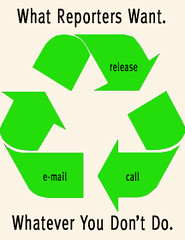Sometimes practical experience is the best teacher. So for 15 minutes last night, practical experience served as the guide in my last class this session.
Students in my Writing for Public Relations class were asked to walk 15 minutes in the shoes of a starting journalist. It only took two before their feet were sore and some eyes glazed over.
They were given seven real news releases and asked to convert them into three 1-paragraph news briefs. (Ideally, I like to provide 10 releases and ask them to write four briefs in 20 minutes, but I wanted to shave some time.)
Within a few seconds, the room filled with the sounds of a newsroom, fingers pounding keyboards. And then ten minutes in I tossed in an interruption.
”Ring, ring. Hi, I’m a PR guy. Do you want to hear about my news?”
No answer.
“Nobody wants to talk to me? How rude. I have some real good news.”
“I will if your news is better than some of these releases,” one student laughed.
“Oh, okay,” I said. “I’m having a press conference tomorrow.”
“What’s it about?”
“We’re going to pop a balloon,” I said, a reference to Bruce Spotleson, group publisher for Greespun Media, who used balloon popping as an example of what press conferences are starting to become — sales events about nothing.
“I’d hang up,” someone else offered.
“Why? Do you have something against balloons? I thought journalists loved pitches. What am I going to tell my client?”
“We’re on a deadline,” another offered.
“Wow, you sound just like those grumpy journalists,” I mused. “Okay, you have three minutes to wrap up.”
No one could believe how quickly the time whizzed by. And no one was really finished or satisfied with the releases. Their assessment of news releases suddenly wasn’t far off from my own: it would be nice if the releases contained news, had hard facts in the first paragraph, adhered to Associated Press Style rules, minimized typos (including company names), didn’t make them feel like they had to call to fact check everything, and didn’t come over in 6-point type (as one did) in order to conform to some silly “one page” rule.
None of them wanted to do to someone else what I did to them — make their job harder under the pressure of a deadline. Sure, it’s not exactly like real life, but it is close enough to make a memorable point. Newspaper staff is shrinking and well-written releases with news sometimes help fill the gaps. Well, hopefully not that much.
”Hmmm… I wonder if social media releases will make it easier?"
While some have high hopes that IABC can create real “standards," I had mixed feelings when I read the announcement from IABC that said they will take the lead (even though I am an active member).
On one hand, it may help speed along the adoption rate — now, two years and counting — of a worthwhile communication tool. On the other, one wonders if it is really appropriate to step in after two years and proclaim a leadership role. I also hope, no matter what they do, they’ll put it to the end-user test like I did with news releases in class — ensuring journalists and others have the option to follow up, but don’t always have to follow up.
Even more importantly, I wonder if most SMRs will really help journalists, bloggers, and stakeholders? Or will they become cool looking marketing sales sheets, written by the same folks who still haven't mastered the news release?
I also wonder what needs to be done. Did they see this, which Geoff Livingston pointed to last year (it's good, despite some marketing heavy copy)? Or this, which I pointed to a few months before that? I hope so. It might dramatically shorten the development cycle.
Rest assured though, one day I’ll probably pass out 10 social media releases to a class and ask them to walk in the shoes of someone else. Something tells me they will still get sore feet, regardless.
Students in my Writing for Public Relations class were asked to walk 15 minutes in the shoes of a starting journalist. It only took two before their feet were sore and some eyes glazed over.
They were given seven real news releases and asked to convert them into three 1-paragraph news briefs. (Ideally, I like to provide 10 releases and ask them to write four briefs in 20 minutes, but I wanted to shave some time.)
Within a few seconds, the room filled with the sounds of a newsroom, fingers pounding keyboards. And then ten minutes in I tossed in an interruption.
”Ring, ring. Hi, I’m a PR guy. Do you want to hear about my news?”
No answer.
“Nobody wants to talk to me? How rude. I have some real good news.”
“I will if your news is better than some of these releases,” one student laughed.
“Oh, okay,” I said. “I’m having a press conference tomorrow.”
“What’s it about?”
“We’re going to pop a balloon,” I said, a reference to Bruce Spotleson, group publisher for Greespun Media, who used balloon popping as an example of what press conferences are starting to become — sales events about nothing.
“I’d hang up,” someone else offered.
“Why? Do you have something against balloons? I thought journalists loved pitches. What am I going to tell my client?”
“We’re on a deadline,” another offered.
“Wow, you sound just like those grumpy journalists,” I mused. “Okay, you have three minutes to wrap up.”
No one could believe how quickly the time whizzed by. And no one was really finished or satisfied with the releases. Their assessment of news releases suddenly wasn’t far off from my own: it would be nice if the releases contained news, had hard facts in the first paragraph, adhered to Associated Press Style rules, minimized typos (including company names), didn’t make them feel like they had to call to fact check everything, and didn’t come over in 6-point type (as one did) in order to conform to some silly “one page” rule.
None of them wanted to do to someone else what I did to them — make their job harder under the pressure of a deadline. Sure, it’s not exactly like real life, but it is close enough to make a memorable point. Newspaper staff is shrinking and well-written releases with news sometimes help fill the gaps. Well, hopefully not that much.
”Hmmm… I wonder if social media releases will make it easier?"
While some have high hopes that IABC can create real “standards," I had mixed feelings when I read the announcement from IABC that said they will take the lead (even though I am an active member).
On one hand, it may help speed along the adoption rate — now, two years and counting — of a worthwhile communication tool. On the other, one wonders if it is really appropriate to step in after two years and proclaim a leadership role. I also hope, no matter what they do, they’ll put it to the end-user test like I did with news releases in class — ensuring journalists and others have the option to follow up, but don’t always have to follow up.
Even more importantly, I wonder if most SMRs will really help journalists, bloggers, and stakeholders? Or will they become cool looking marketing sales sheets, written by the same folks who still haven't mastered the news release?
I also wonder what needs to be done. Did they see this, which Geoff Livingston pointed to last year (it's good, despite some marketing heavy copy)? Or this, which I pointed to a few months before that? I hope so. It might dramatically shorten the development cycle.
Rest assured though, one day I’ll probably pass out 10 social media releases to a class and ask them to walk in the shoes of someone else. Something tells me they will still get sore feet, regardless.























